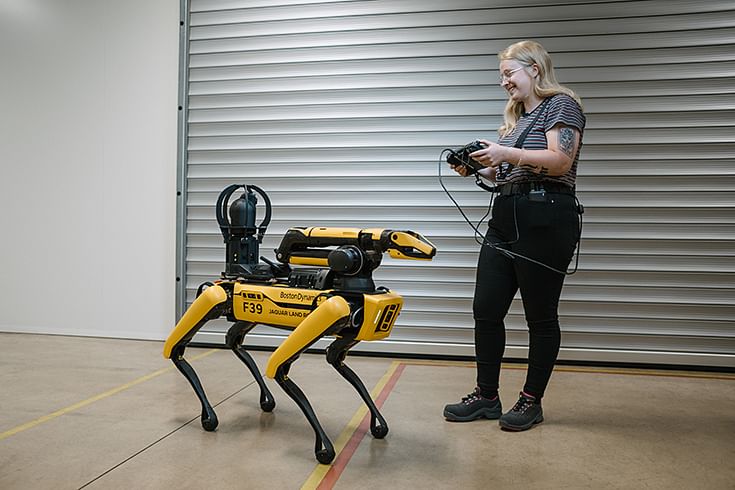JLR deploys AI-driven robotic guard dog 'Rover' to patrol EV test facility
‘Rover’ patrols the EV build and test facility in Coventry up to 24 times a day; constantly checks high‑tech equipment is working to standard, allowing engineers to spend valuable time on maintenance; quickly evaluates test battery temperatures to increase environmental safety.
JLR’s EV build and test facility in Coventry, UK – which plays a crucial role in the luxury vehicle manufacturer’s plan to electrify all of its brands by 2030 – has added an unlikely colleague to its list of new recruits, in the form of a four‑legged robotic dog dubbed ‘Rover’.
With the test facility a complex and energy‑dense environment, with thousands of assets that requires constant monitoring, Rover’s role as guard dog is of critical importance to JLR and its human colleagues – saving them valuable time by spotting potential operational issues and equipment wear and tear early, ensuring test and development continues to run on schedule ahead of the launch of Range Rover Electric.
Just like a regular guard dog, ‘Rover’ has its own kennel at the plant, where it periodically lives and charges its 50V battery between shifts. However, unlike a regular dog, Boston Dynamics’ robot can operate 24 hours a day, 7 days a week, and doesn’t get distracted by loud sounds, unusual sights or smells.
 'Rover' conducts up to 24 patrols each day and night, using AI to physically open doors, ascend stairs and navigate high‑traffic areas with diligence
'Rover' conducts up to 24 patrols each day and night, using AI to physically open doors, ascend stairs and navigate high‑traffic areas with diligence
Fully automated to follow a range of pre‑set routes, Rover conducts up to 24 patrols each day and night, using AI to physically open doors, ascend stairs and navigate high‑traffic areas with diligence. Continuously taking measurements and inspecting valves and machinery, Rover eliminates the risk of human error in these tasks, while allowing engineers to better spend their time analysing Rover’s results to make more insightful business and maintenance predictions or to perform repairs.
 'Rover' with his handler. ‘Rover’ patrols the EV build and test facility in Coventry up to 24 times a day, constantly checks high‑tech equipment is working to standard, and quickly evaluates test battery temperatures.
'Rover' with his handler. ‘Rover’ patrols the EV build and test facility in Coventry up to 24 times a day, constantly checks high‑tech equipment is working to standard, and quickly evaluates test battery temperatures.
Performing his duties with aplomb, the quadruped is able to do so thanks to the natural dexterity afforded by its four legs and robot arm. These in turn are maximised by its advanced onboard sensors – ‘hearing’ potential gas leaks that would otherwise not be sensed by human ears, and using thermal sensors to evaluate battery temperatures quickly, ensuring technicians can continue their work safely.
“Key to JLR’s Reimagine strategy is a continual collaboration with the industry’s brightest minds, developing advanced robotics solutions that work in harmony with our employees for the uncompromising benefit of our clients.
“Enabling our engineers to work safer and smarter, collaborations such as this one with Boston Dynamics are key. Not only are they essential in realising our ambition to electrify our Range Rover, Defender, Discovery and Jaguar brands by 2030, they also have an important role to play in ensuring that the final vehicles that roll off the line have only the very best EV battery technology within them,” said Gonzalo Ejarque‑Rinaldini, PhD Automation and Robotics at JLR
With Boston Dynamics’ Rover already performing vital duties within JLR’s EV build and test facility at Lyons Park, JLR is now scoping out future use scenarios for a fleet of robotic quadrupeds across its entire global industrial footprint. This includes at its Solihull plant where preparations are well underway for the launch of Ranger Rover Electric, and also where Jaguar will begin an exciting new era as a pure‑electric modern luxury brand – the first of which will be a 4‑door GT, the most powerful and sustainable Jaguar ever with a range of around 700km, priced from £100,000.
JLR’s investment into robotics forms part of the luxury vehicle manufacturer’s wider £18 billion (Rs 183,474 crore) investment into its Reimagine strategy, with Lyons Park also proofing the use of plasma cleaning robots. These robots have a pivotal part to play, removing microscopic dust particles from battery cells ahead of bonding, which would otherwise not be visible to the human eye.
Images: JLR
RELATED ARTICLES
First BYD EV rolls off the line at new plant in Brazil
Chinese EV maker takes just 15 months from breaking ground to producing the Dolphin Mini, the first locally manufactured...
Volkswagen Group honours 10 outstanding suppliers, strengthens strategic collaboration
The 21st Volkswagen Group Award recognized suppliers for outstanding performance and contribution over the past year. VW...
Volkswagen Group sells 465,500 BEVs worldwide in first-half 2025, up 47%
With strong growth in Europe (+89%) and the USA (+24%), despite a sales decline in China (-34%), the VW Group’s global B...





 By Autocar Professional Bureau
By Autocar Professional Bureau
 13 Sep 2024
13 Sep 2024
 3386 Views
3386 Views




















